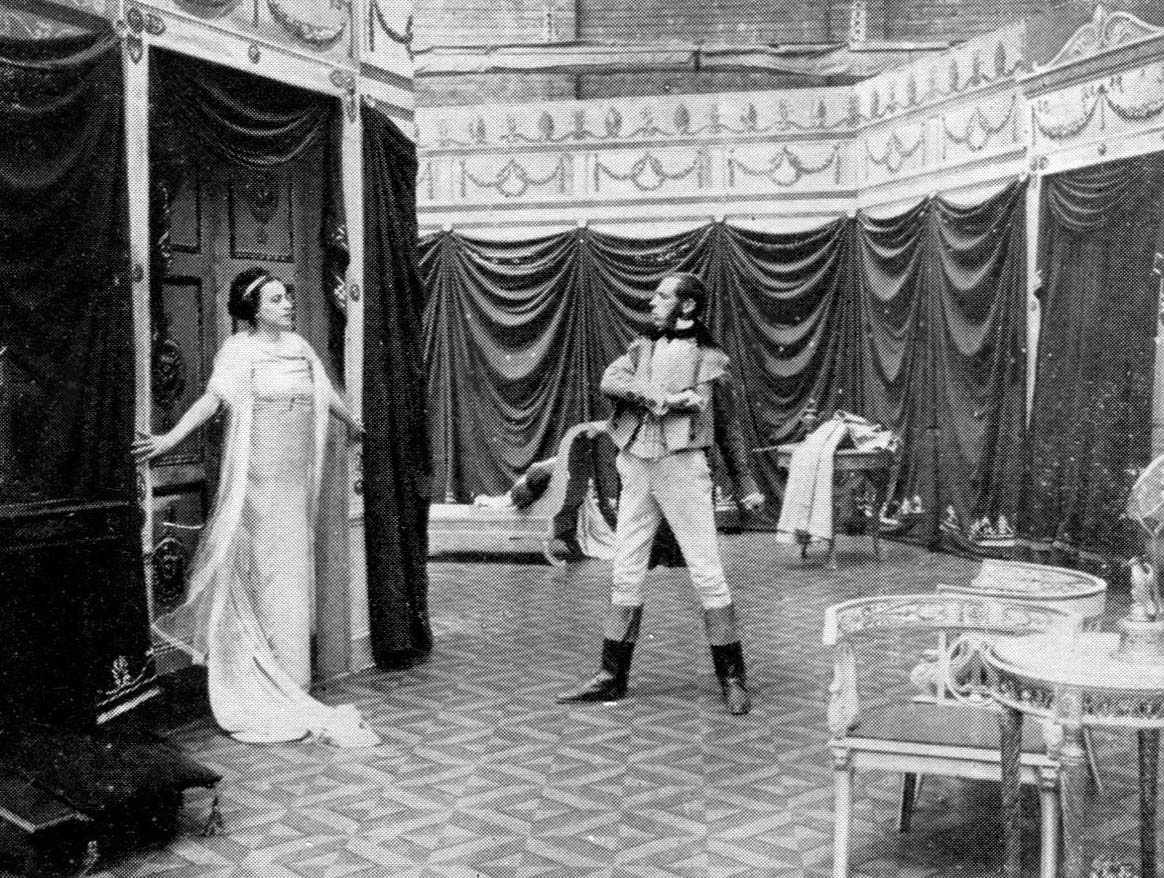SPERGIURA!
(US: The False Oath)
Luigi Maggi, Arturo Ambrosio (IT 1909)
1909 was the year when everyone was scrambling to adapt Balzac’s short story “La Grande Bretèche” for the screen. The Italians got there first in July with Spergiura! (literally “Swear on that!”), swiftly followed by the Americans in September (Biograph’s The Sealed Room), the French in October (Pathé’s La Grande Bretèche), and the Americans again one week later (Vitagraph’s Entombed Alive). The latter is lost, but the opportunity to screen the three surviving films allows us a rare chance to compare filmmaking styles, along with the national peculiarities of literary adaptation. The chilling tale, which Edith Wharton called “that most perfectly-composed of all short stories,” is a dramatist’s dream: the Countess de Merret has a Spanish lover whom she entertains while her husband is away. When the Count returns unexpectedly, his wife hides her lover in a closet. Noises are heard, making the husband suspicious, but his wife swears no one is in her room. Unconvinced, he has a mason brick up the closet and forces his wife to remain with him in her bedroom for twenty days, until the noises of her suffocated lover are no longer heard.
Balzac’s popularity in Italy was enormous: Charles-Augustin Sainte-Beuve wrote about a time when members of Venetian high society would consciously emulate the novelist’s characters, to the point where “one saw nothing but Rastignacs, Duchesses de Langeais, and Duchesses de Maufrigneuse”. Such was the impact of “La Grande Bretèche,” initially published in 1831, that the first Italian translation had already appeared in 1837. For modern readers, the unnerving theme suggests Edgar Allan Poe, particularly “The Cask of Amontillado”, yet Poe’s tale appeared 15 years later, in 1846. For scenarist Arrigo Frusta, who’d been devouring the classics since childhood, the story jumped out as ripe for filming.
Hired by Arturo Ambrosio in 1908, Frusta (1875-1965) was a rapid-fire, endlessly inventive scriptwriter whose brief memoir, published in Bianco & Nero in 1952, provides an invaluable account of his early years at the studio. In florid style he describes tackling “La Grande Bretèche,” reshaping it “with the most fiercely Radcliffian situations … Ambrosio immediately fell in love with the subject. He wanted me beside him to discuss it at length, to create shots and flow, choosing the blocking and the actors, assigning parts and seeing to the tiniest details.” Ambrosio was so taken with the possibilities afforded by the script that he started what Frusta calls a revolution: “No more sunbeams and mirrors, painted backdrops, no more windows and doors made of stage flats; but real rooms, windows with glass, genuine columns, tiled pavement, polished floors. And real furniture, gilded, and silk curtains, and expensive rugs, luxury, a never before seen display … One rehearsal after another; endless discussions, and tantrums and glowering faces.” Frusta did away with Balzac’s introductory narration, focusing instead on the clandestine love affair between the adulterous Marchesa Bianca Maria (Mary Cléo Tarlarini) and her dragoon officer lover (Alberto A. Capozzi), played out in the spectacularly grand setting of Turin’s Villa della Regina. Directors Luigi Maggi and Ambrosio himself build tension by shifting between the couple and the Marchese (Maggi), with an exciting fade-in of the husband riding furiously alongside a river. The climax sees the wife swearing there’s no one in her closet (according to Frusta, “the tableau (in extreme close-up) of the swearing hand was a new thing”), but when she realizes her lover is completely walled-in, she collapses.
Spergiura! was the studio’s first release in their new Gold Series (“serie d’Oro”), and critical reaction was electrifying; so popular was the film that it was reissued in 1914 and was still playing one year later – the Empire Film Company released it in the U.S. as The False Oath in the week of 6 November 1909, with Ambrosio himself on hand to help with the marketing. Frusta capitalized on the story’s success a few months later with a further reworking of the story, La stanza segreta (dirs. Luigi Maggi, Giuseppe Gray?, 1910), released in the U.S. as The Room of the Secret.
Jay Weissberg

regia/dir: Luigi Maggi, Arturo Ambrosio.
scen: Arrigo Frusta, dal racconto di/based a short story by Honoré de Balzac (“La Grande Bretèche”, 1831).
photog: Giovanni Vitrotti.
scg/des: Decoroso Bonifanti.
cast: Mary Cléo Tarlarini (Bianca Maria), Alberto A. Capozzi (l’ufficiale dei dragoni/officer of the Dragoons), Luigi Maggi (il marchese di Croixmazeu/Marquis of Croixmazeu), Luigi Bonelli, Mirra Principi.
prod: Ambrosio (Serie d’Oro).
uscita/rel: 16.07.1909.
v.c./censor date: 26.10.1914 (n. 4980; riedizione/reissue).
copia/copy: 35mm, triacetato/triacetate, 225 m. (orig. 253 m.), 12′ (18 fps), col. (imbibito/tinted); didascalie mancanti/intertitles missing.
fonte/source: Museo Nazionale del Cinema, Torino.
Restauro/Restoration: giugno/June 2009; Cineteca del Comune di Bologna, Museo Nazionale del Cinema, Deutsche Kinemathek, presso il laboratorio/at the laboratory L’Immagine Ritrovata, a partire da un positivo nitrato della/from a nitrate print held by the Deutsche Kinemathek.


 Italiano
Italiano